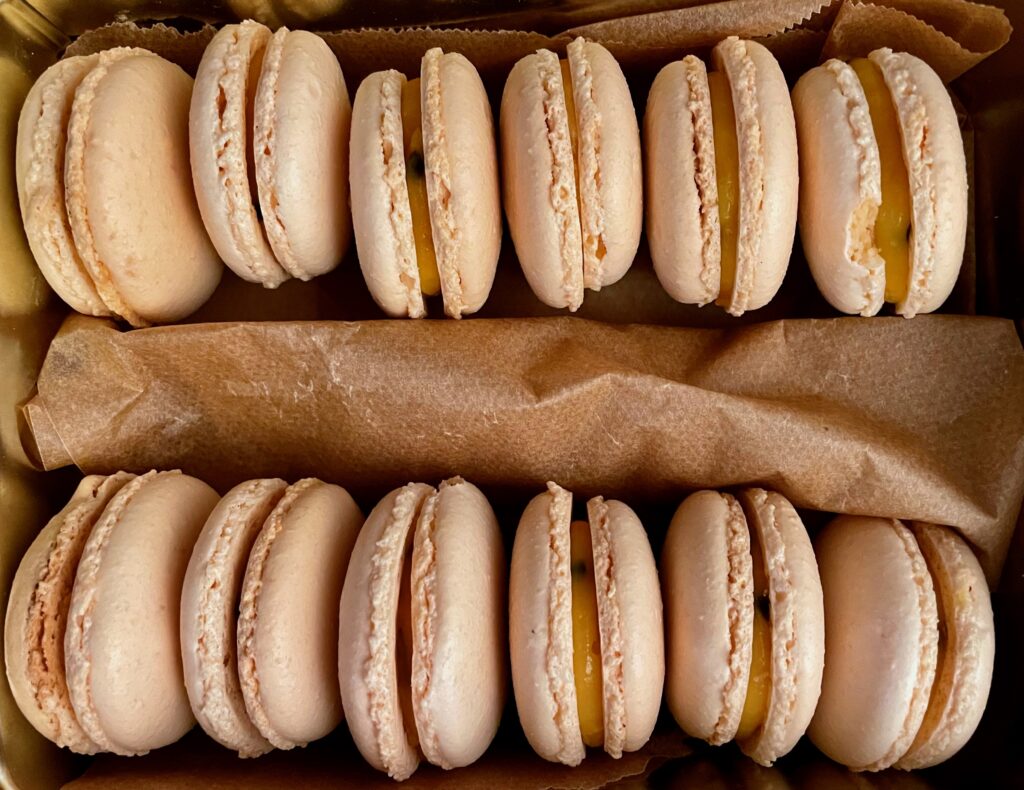A baking challange
A well-made macaron has a smooth crispy shell, well risen foot, a chewy interior and a delicious filling. Achieving this is a little tricky. Macaron shells require several steps that need experience to judge properly (no recipe or video can convey quite how to get it right) so practice is important. Despite the challenge they are worth persevering, macarons always go down well and are great to share.
I devised this recipe to use the egg yolks left over from making the shells to make a rich passion fruit curd to sandwich them together. Passion fruit are great in the winter and make sure yours are wizened and ripe before cutting open.
These macarons use the Italian method, which I find more reliable than the slightly simpler French method.
Makes around 20 macarons and takes a little under 2 hours.
You will need…
Macron shells
- 170g ground almonds
- 160g icing sugar
- ¼ tsp orange powdered food colour [optional]
- 4 medium eggs
- 160g granulated sugar
- 50ml water
- ¼ tsp cream of tartar
Curd
- 4 ripe passion fruits
- Few drops of lemon juice
- 70g unsalted butter in cubes
- 100g golden caster sugar
- Egg yolks from the eggs above
- 1 tbsp cornflower
To make macarons…
- Put the almonds, icing sugar and powdered food colour (if using) in a food processor and whizz on high speed until combined and even in texture. Put into a medium bowl.
- Separate the eggs, put two whites in the bowl with the almonds, two in the bowl of a stand mixer and set the yolks aside in a bowl till later. Place the mixer bowl under the mixer with a whisk attachment.
- Mix the almonds and egg yolks together with a spatula to form a thick paste.
- Put the granulated sugar and water into a small pan and heat over a medium/high heat till the sugar dissolves. Insert a sugar thermometer and keep heating. As soon as the syrup reaches 110°C switch on the stand mixer to medium high to start whipping the eggs. Keep a careful eye on the syrup and the eggs. Once the eggs reach a stiff peak add the cream of tartar and whisk in.
- When the syrup reaches 118°C (called the firm ball stage) take from the heat. Switch the mixer on high and slowly drizzle the syrup into the egg whites tomake an Italian meringue. Once all the sugar has been incorporated keep whisking on high until the meringue cools to the touch
- Mix the meringue and almond mixture in a process called macaronage. Add the almond into the meringue and using a spatula combine the two using a folding action. The more the mixture is folded the more air is removed and the slacker the batter becomes. Judging the right point to stop stirring is key, the batter needs to flow to form a rounded dome with no ridges, but not too much to flatten out. A simple test is once the meringue and almonds are mixed with a ribbon of batter falling from the spatula make the shape of a figure of 8 on top of the mass and to wait a couple of minutes. The right consistency is achieved when the figure of 8 absorbs slowly back into the batter below.
- Line two large baking sheets with baking paper. Spoon the batter into a large piping bag fitted with a medium round tip (a Walton 1A works well).
- Carefully pipe rounds of batter about 2.5cm (1 inch) in diameter.
- Once a tray is full pick it up and drop if, from a height of about 5cm (2 inches) onto the work surface. Repeat this three times to bring any bubbles to the surface of the macaron. Pop any obvious bubbles with a cocktail stick. Leave the trays to stand for about 30 minutes, until a skin forms on the top. If your room is humid or especially cold this may take a bit longer.
- Switch the oven on to 160°C fan / 170°C non-fan.
- Whilst the macarons are setting make the curd by cutting the passion fruits in half and scooping the flesh into a sieve over a bowl. Vigorously stir the flesh to remove the juice from the seeds.
- Put the egg yolks in a small pan, add the caster sugar and cornflower and stir, add the passion fruit and lemon juice, butter and a tablespoon of the seeds from the sieve. Stir over a medium heat until thickened. Pour the curd into a small tray to cool, cover the top surface with film to prevent a skin forming.
- Once a skin has formed pop the trays into the oven and bake for 15 minutes.
- Take the macarons from the oven and pull the paper from the oven sheet to a work surface to speed cooling. Let the macarons cool and firm up for a few minutes then gently peel from the paper and put on a cooling rack.
- Pair up the macaron shells – choosing shells of a similar size to go together.
- Scoop the set curd into a small piping bag, cut a small hole in the end of the bag and pipe onto half the shells to fill, add the other shell.
- Enjoy!
